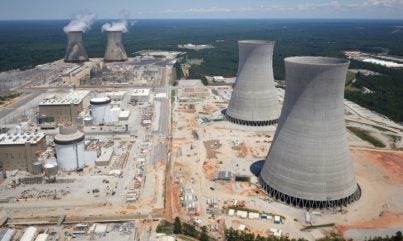
US utility Georgia Power has filed its 2025 Integrated Resource Plan (IRP) with the Georgia Public Service Commission (PSC) proposing power uprates at its Hatch and Vogtle NPPs as well as additional nuclear power capacity over the long-term. Georgia Power, a subsidiary of Southern Company, has proposed necessary investments in its generation fleet and transmission system to help provide its customers with “the reliability and resiliency they deserve and expect, as well as demand-side and customer programmes”.
Georgia Power said it “continues to see positive economic development trends, in the short and long term, with many of the businesses coming to the state bringing large electrical demands”. Over the next six years, it projects approximately 8,200 MW of electrical load growth – an increase of more than 2,200 MWe in peak demand by the end of 2030 compared with projections in the 2023 IRP Update approved by Georgia PSC in April 2024.
The company has identified opportunities to upgrade several existing nuclear units to provide additional capacity. “This additional baseload energy can aid in meeting growing capacity needs without the need for incremental transmission system investment.”
Georgia Power proposes extended power uprates (EPUs) at Vogle units 1&2 and Hatch 1&2. Between 2028 and 2034, it plans to an additional 112 MWe of capacity at the four units. This includes 27 MWe each at Vogtle 1&2, 30 MWe at Hatch 1 and 28 MWe at Hatch 2. “The EPU process includes an extensive analysis of plant systems and components to verify the capability and identify needed modifications to support the power upgrade at each facility,” Georgia Power noted.
Hatch NPP is co-owned by Georgia Power, Oglethorpe Power Corporation, Municipal Electric Authority of Georgia and Dalton Utilities and operated by Southern Nuclear. It comprises two 900 MWe boiling water reactors (BWRs). Unit 1 began commercial operation in December 1975, and unit 2 in September 1979.
Vogtle NPP comprises four pressurised water reactors. Units 1&2 – both 1,215 MWe reactors supplied by Westinghouse – were completed in 1987 and 1989. Vogtle 3&4 are both 1,117 MWe Westinghouse AP1000 reactors. Unit 3 began commercial operation in July 2023 and unit 4 in April 2024.
At Hatch, Georgia Power is also planning to complete a necessary upgrade to the BWRs – a Maximum Extended Load Line Limit (MELLA+) enhancement. This increases capacity by allowing for increased thermal power without increasing core flow to support EPU for BWRs. At Vogtle, the company is considering an option for units 1&2 that would transition outages to a 24-month cycle. This would extend unit run times and decrease the number of refuelling outages.
Georgia Power said it is working with the US Nuclear Regulatory Commission (NRC) as a part of the required review and licensing process. NRC will review the licence amendment request that contains the detailed analysis to support the power upgrades and grant approval to allow the upgrade of each facility.
As to additional capacity, Georgia Power said it develops “multiple views of future cost and performance of generating technologies, multiple views of future electricity consumption, and multiple views of the future price of fuels to support expansion planning for future years of need”. Accordingly, 2025 scenarios “select nuclear generation in six of nine scenarios over the 20-year planning horizon and as early as 2037”.
However, it is cautious: “Even with new nuclear generation’s numerous benefits, undertaking the construction of new nuclear generation carries substantial risks for all stakeholders involved. Before proposing additional new nuclear generation, the company believes that solutions must be developed to adequately balance and mitigate risks to stakeholders.”
The history of Vogtle 3&4 is clearly a consideration. The two units were originally expected to cost about $14bn and to enter service in 2016 and 2017 but suffered a series of delays, including Westinghouse’s bankruptcy in 2017. The total cost of the project to build Vogtle 3&4 is now put at more than $30bn.
While “preserving viable new nuclear generation options for the benefit of customers is a priority”, Georgia Power “continues to perform in-depth assessments of potential project sites, evaluate available and emerging technologies, and engage with stakeholders in developing improved methods to deploy new nuclear generation projects”.
It adds: “Over the long-term, with adequate additional risk mitigations and leveraging the experience gained with Vogtle units 3-4, the company believes customers would benefit from additional new nuclear in the future.”
Kim Greene, Georgia Power Chairman, President & CEO noted: “At Georgia Power, our vision extends far beyond today – we plan for tomorrow, the next ten years and decades to come,” said. “As Georgia continues to grow, this state is well-positioned for the future thanks to proactive planning, policies, and processes like the Integrated Resource Plan. The 2025 IRP provides a comprehensive plan to support Georgia’s continued economic growth and serve Georgians with clean, safe, reliable and affordable energy well into the future.”






